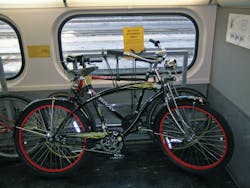San Francisco Bay Area Railroad Welcomes Cyclists
Passenger trains have been operating on the San Francisco Peninsula since Lincoln was president. Today, Caltrain operates 86 trains that provide a mix of local, limited and express service on the historic right of way between San Francisco and Silicon Valley.
Even in this bleak economy, average weekday ridership is 46,000. In fact, ridership has increased for the last 22 consecutive months and sometime this summer, it is expected that to match the historic high of 46,169 set in July 2008.
One of the reasons for Caltrain’s success is its extensive bicycle program.
Caltrain first welcomed bikes onboard trains in 1992 with a pilot program that allowed four bikes on a few trains. Over the years, the rail agency has made incremental improvements in capacity.
Last year, Caltrain completed a project to ensure that every train is equipped with two bike cars. Caltrain’s older Gallery-car trains are equipped with two bike cars with a capacity for 40 bikes in each car for a total capacity of 80 bikes on each train. The newer Bombardier cars are able to hold 24 bikes per car for a total capacity of 48 bikes per train.
Average weekday bike ridership saw a nearly 16 percent increase in 2012 over the previous year in 2011 jumping from 3,664 riders to 4,243.
To accommodate bikes, the seats on the lower level of the bike car have been replaced with custom-made bike racks equipped with bungee cords. A maximum of four bicycles can be stored in each bicycle rack.
To facility boarding, the bike cars are located on the northernmost end of the train and in the middle of the train. The bike car is noted with a yellow bike decal on the outside. Cyclists use bright yellow destination tags, prominently displayed, to indicate where they are getting off the train.
Folding bikes that can be stored under the seat in front of the owner or in the luggage rack are allowed on any train car.
Boarding of bicycles is on a first-come, first-served basis. If the bike car is full, cyclists may have to wait the next train. The bike cars on some of Caltrain’s most popular commute-hour trains are at capacity.
With limited onboard bike space, cyclists are encouraged to park their bike at Caltrain stations, when feasible.
Attended bike parking facilities, commonly known as "bike stations", allow bikes to be checked in and out with an attendant, similar to valet parking for cars.
The San Francisco Bike Parking Facility provides free, secure bike parking for 130 bikes. Bikestation Palo Alto, located at the Palo Alto Caltrain Station, accommodates 96 bicycles in a double-tier rack. Members can park or retrieve their bikes at any time, not just during staffed hours, using round-the-clock electronic key access. Approximately 80% of Bikestation Palo Alto users park their bicycle overnight at the facility.
The Mountain View and Menlo Park stations have secure bike shelters. Bike lockers are offered at 27 stations. Bike racks are available at almost all Caltrain stations.
Bike sharing is another way to accommodate cyclists. Five Caltrain stations will be the site of bike stations in the first regional bike sharing program in the country. Scheduled to launch later this year, the pilot program will provide 1,000 bicycles for use on a subscription basis.
Additional bike stations will be located high-density residential areas and key destination points such as schools and employment centers. The results from the pilot will be used to evaluate bike sharing’s potential to improve air quality by replacing short car trips with zero-emission bicycles.
To continue to improve its bicycle program, Caltrain formed a Bicycle Advisory Committee in 2010. The committee is the primary venue for the interests and perspectives of bicyclists, bringing new ideas for discussion and helping Caltrain guide its future investments.
Many things have changed since the 1890’s, when the safety bicycle and the pneumatic tire made bike riding a national craze and it took a steam engine almost 2 ½ hours to travel from San Francisco to San Jose. Today, bikes are made of advanced steel alloys and even bamboo. In some countries, e-bikes, which use rechargeable batteries, are rapidly replacing traditional bikes. And, Caltrain is poised to electrify its system. With its potential to bridge the “last mile” between transit centers, residential neighborhoods and employment sites, the lowly bicycle shows that everything old is new again.
Christine Dunn is Caltrain's public information officer.
